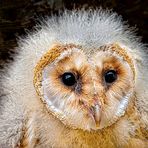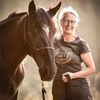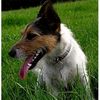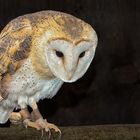Barn owl
( Tyto alba )
Size: 33 - 35 cm
Weight: 300 – 350 g
Wingspan: 85 - 95 cm
Barn owls feed mainly on small mammals such as field and shrews, rarely on birds, occasionally on amphibians, reptiles and large insects.
To meet their daily food requirements of 80 - 100 g, a Barn Owl catches about 4 - 5 mice per night.
As cultural followers, they live in close proximity to humans and prefer open lowlands with fields and villages that provide them with food and breeding sites. They inhabit a territory of 5 - 10 km2 and are considered to be extremely faithful to their location.
They leave their territories only in case of acute food shortage or severe winters.
However, due to the rapid reduction of breeding sites through conversion or modernization of older buildings and church towers and modern agricultural production methods, the space for the barn owl is becoming smaller and smaller.
Thus, barn owls are becoming increasingly rare in our latitudes.
In German folklore, the barn owl was once considered a witch and devil bird,
heralding fire, lightning and death.
To protect against this, the "fire and flame owl" was still nailed to barn and farm gates with its wings spread until the 20th century. At the same time, the dead owl was supposed to protect the domestic fowl from the grasp of the hawk or other animals.
Barn owls are protected and are on the Red List of threatened species.
Schleiereule
Grösse: 33 - 35 cm
Gewicht: 300 – 350 g
Flügelspannweite: 85 - 95 cm.
Schleiereulen erbeuten hauptsächlich Kleinsäuger wie Feld- und Spitzmäuse, seltener Vögel, vereinzelt Amphibien, Reptilien und Großinsekten.
Um ihren täglichen Nahrungsbedarf von 80 - 100 g zu decken, fängt eine Schleiereule pro Nacht etwa 4 - 5 Mäuse.
Sie leben als Kulturfolger in enger Nachbarschaft zum Menschen und bevorzugen offene Niederungen mit Feldern und Dörfern, die ihnen Nahrung und Brutplätze bieten. Sie bewohnen ein Revier in Größen von 5 - 10 km2 und gelten als überaus standorttreu.
Ihr Gebiet wird nur bei akutem Nahrungsmangel oder in strengen Wintern verlassen.
Aber durch die rapide Verringerung des Brutplatzangebotes durch Umbau oder Modernisierung ältere Gebäude und Kirchtürme und durch die moderne landwirtschaftliche Produktionsmethoden wird der Raum für die Schleiereule immer kleiner
sodass auch die Schleiereulen in unseren Breiten immer seltener werden.
Im deutschen Volksglauben galt sie früher als Hexen- und Teufelsvogel,
der Feuer, Blitzschlag und Tod verkündete.
Um sich davor zu schützen, wurde die "Feuer- und Flammeneule" noch bis ins 20. Jahrhundert mit ausgebreiteten Flügeln an Scheunen- und Hoftore genagelt. Gleichzeitig sollte die tote Eule so das Hausgeflügel vor dem Zugriff des Habichts oder anderer Tiere bewahren.
Die Schleiereulen stehen unter Naturschutz und stehen auf der roten Liste der bedrohten Tierarten.

Barn Owls Baby
Babs Sch
For health reasons (read in my profile)
I can not write comments on your photos.
I hope you will understand this.
Thank you for visiting my website.
I am glad that you come and keep coming back.
I also thank you for your comments, your compliments and your favorites,
they encourage me.....
I send you warm regards
Babs
Aus gesundheitlichen Gründen (in meinem Profil nachzulesen)
kann ich keine Kommentare zu deinen Fotos schreiben.
Ich hoffe, du hast dafür Verständnis.
Ich danke dir herzlich für deinen Besuch auf meiner Website.
Ich freue mich, dass du kommst und wiederkommst.
Ich danke dir auch für deine Kommentare, deine Komplimente und deine Favoriten,
sie ermutigen mich.....
Ich sende Dir herzliche Grüße
Babs





















Rainer Switala 11/05/2023 15:13
gut erwischt von dirprima info
gruß rainer
Fotosüchtig 10/05/2023 15:50
Wunderbare Aufnahme, gut inszeniert und sehr gut freigestellt. Mit den Erläuterungen hast du dir wieder sehr viel Mühe gemacht. Gruß HorstLaelia Letombe 09/05/2023 13:38
top ++++amts laeliaKurt Stamminger 09/05/2023 12:51
Erstklassig. LG Kurtpatrick hyrailles 09/05/2023 12:08
beau cliché bravoalicefairy 09/05/2023 7:50
wunderschön ist sieLg Alice
Marguerite L. 09/05/2023 7:17
fabelhaft!GrüessliM
Adele D. Oliver 09/05/2023 2:58
a truly magnificent owl, and your portraitsuperb with its closeness and sharp details
amd light !!
warm regards,
Adele